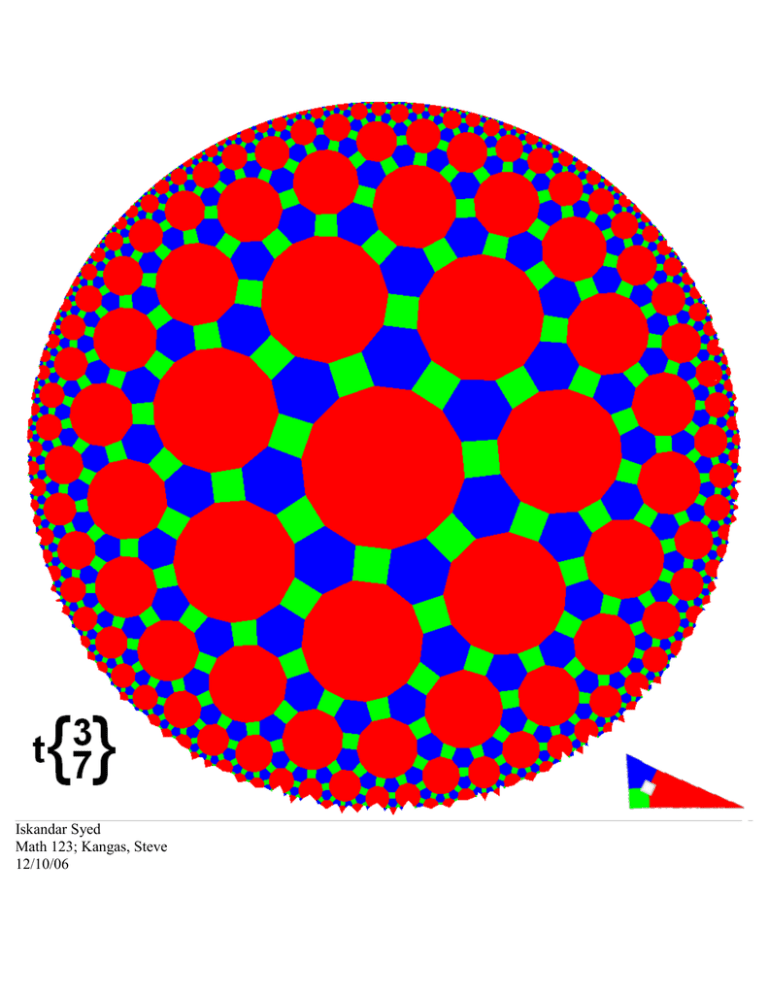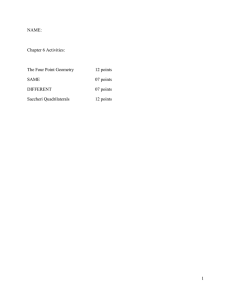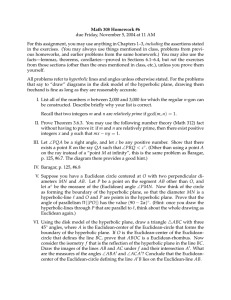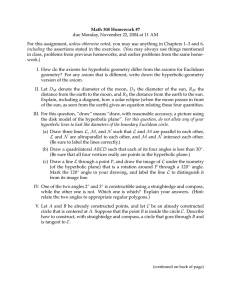Iskandar Syed Math 123; Kangas, Steve 12/10/06
advertisement

Iskandar Syed Math 123; Kangas, Steve 12/10/06 Hyperbolic Trigonometry and Euclidean Trigonometry: Differences and Similarities Trigonometry is the study between angles and sides of a triangle. The hyperbola comes from the conic section family. The conic section has four shapes; those are the circle, the ellipse, the parabola and the hyperbola. The Euclidean geometry deals with trigonometric equations that take place on a 2 dimensional plane. A parallel line on a Euclidean plan is constant. The function for a hyperbola on the Euclidean plane is y = x^2. The hyperbolic plane on the other hand is a 3 dimensional plane and uses the function x^2/a^2 – y^2/b^2 = ± 1 also known as a hyperboloid and has infinite parallel lines that curve away from each other maximizing their distance from one another. In spite of the difference of planes they still both consist of identities that can be interchanged between the two trigonometric planes. These identities are according to Osborne’s rule, interchangeable. The formulas that apply are the additional and subtraction formulas, the double angle formulas and the half angle formulas. This rule also includes complex numbers. But in order to make use of the formulas, the sin, cos and tan functions have to be switched to sinh, cosh, and tanh functions and swap the negative and positive signs. A useful relation is that the even and odd functions are the same between the two planes (Cosh x and Sech x are even functions just like cos x and sec x are even functions). In most problems of trigonometry, similar triangles can be applied to get a solution. However, in hyperbolic trigonometry the use of similar triangles are no longer valid. The differences can be seen when applying the law of Cosines and the law of Sines for a triangle. The hyperbolic law of Sines and the hyperbolic law of Cosines differ from their Euclidean counterpart due to the nature of parallel lines. The nature of the parallel lines on each plane is basically the difference between Euclidean geometry and Hyperbolic geometry. It is then easy to see the connection between the two planes provided that the equation has basic geometry. A most commonly seen connection is in bridge design construction. From a simple glance it is plain sight that a suspension bridge cable is in the general shape of a hyperbola. Through further investigation this assumption is not only true but it provides a connection between the hyperbolic trigonometry and the Euclidean trigonometry by means of circular functions. Using the polar coordinate (0,π/2) it is almost impossible to distinguish which plane you are in. Works Cited: 1. “30 Bridges” -by Matthew Wells. Watson-Guptill Publications, New York. 2002. 2. “Hyperbolic Trigonometry” and “non Euclidean Plane” – wikipedia. 12/05/2006


